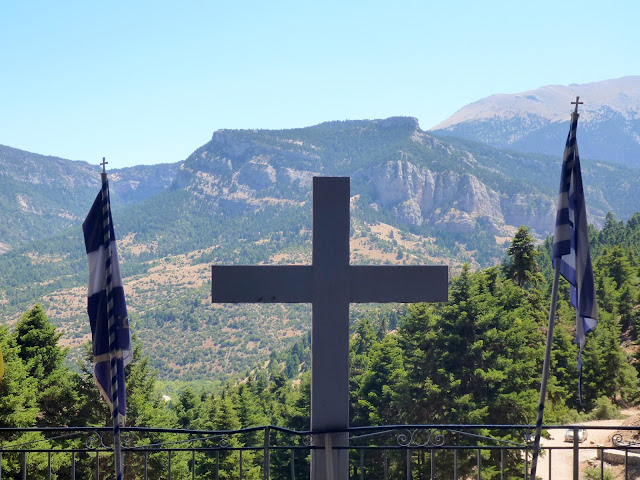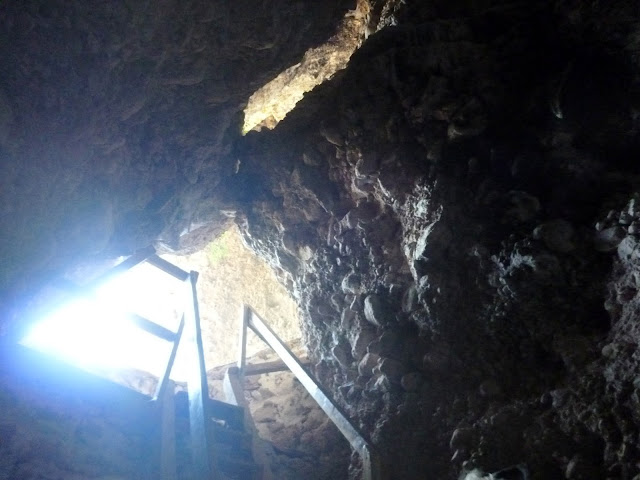On our first full day in Upper Korinthia, we left the village of Trikala where we were staying, and drove up the mountains - our destination, the Virgin of the Rock which is located near the town of Kato Tarsos near Feneos.
The mountains are covered with pines. Snow is abundant here in the winter and I presume the roads must become impassable at times.
But, in August, the sun was shining and the scenery was something we do not associate with Greece
at least, not the Greece of picture postcards.
We got our first glimpse of the so-called Meteora of the Peloponnese soon enough, bare jutting rock that rose above us
we then turned a corner and more pines all around us
we then got a better view of the Meteora, which was our destination.
At every turn the views would change
and teasingly, the rocks of the Meteora would reappear.
It was all spectacularly beautiful.
We abandoned the main road and turned into a dirt track which was really hard on the car. Stathis, my brother-in-law, pointed at the rock ahead of us, and asked 'can you see the cross?'
We could hardly see it, but it's clear in the photograph above, when I zoomed in with my camera
We continued driving
We eventually arrived, parked the car and started walking
In the middle of the crag, behind the cross is a two-level cave. The lower level is now a church, while the upper level was used by the locals as a refuge from the Turks during the 400-year Ottoman occupation of Greece.
It is believed that the upper level was also used as a krifo scholio, a secret school. The Ottoman authorities prohibited education in Greek obliging the Greek people to organise small, secret schools in monasteries and churches. These schools are often credited with having played a decisive role in keeping Greek language and literacy alive through the period of Turkish rule in Greece between the 15th and 19th centuries.
Legend has it that the church was created by a woman from Tarsos during the time when Mohammed the Second's army besieged and attacked the town of Tarsos in 1458. All the women of the town were killed, taken hostage or committed suicide by throwing themselves off the rock in order to avoid capture. One woman threw herself off the rock while holding her child and as she was falling, she cried out: 'Virgin, Mother of God, save me'. She survived the fall and in gratitude placed a few icons in the cave. This was the beginning, more people brought icons and the church was born.
Wonderful views when we reached the top of the steps
we stopped at the entrance, looked at the icon,
and took some time to admire the view.
The lower cave consists of at least five chambers - difficult to remember as it progressively got darker
icons, incense burners, candles. The passage leading to the next chamber was very low: Ken had to stoop to get in
and then it got so dark that we had to walk very carefully, sometimes in total darkness. In one of the chambers of the cave we managed to discern a coffin where the bones of those who had lived as Christian hermits in the cave were kept. There are frescos on the walls which date from the middle of the 19th century, painted by Asimakis Skaltzas. We could not see those as we were totally unprepared and had no torch with us.
A ladder led up to an upper storey
and to a platform

We could see the Ziria mountain range, our car and the little shrine at the bottom of the steps that lead up to the cave
This square hole in the rock, this window, led us to think that this might be the second level where the locals used to hide from the Turks, but we're not sure
one more photograph of the bell,

Ken was busy. He had found a broom and was sweeping up all the debris inside the shrine
and all along the path. Bless!

































The landscape looks like the north of Greece - such a diverse country. How wonderful to have all that magnificence to yourselves. How great also the small token of respect when in general human beings otherwise seem to contribute detritus wherever they pause. What a pity you did not get to see the frescos, but fantastic nonetheless. Thanks for sharing.
ReplyDeleteIt is such a diverse country indeed - I remember us driving through some amazing snow drifts on our way to Ioannina. And yes, part of the loveliness of this visit was the fact that it was just us. It was an experience.
Delete